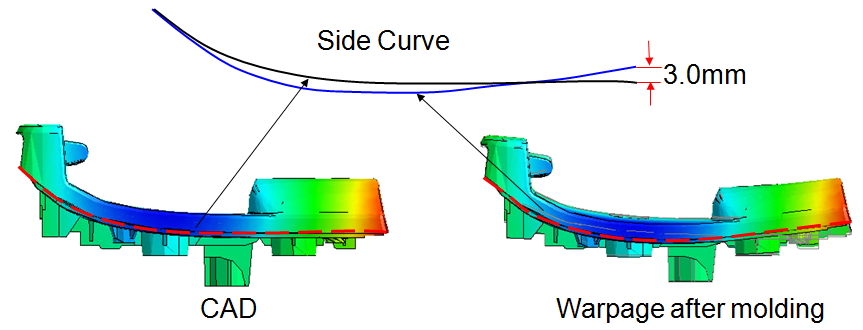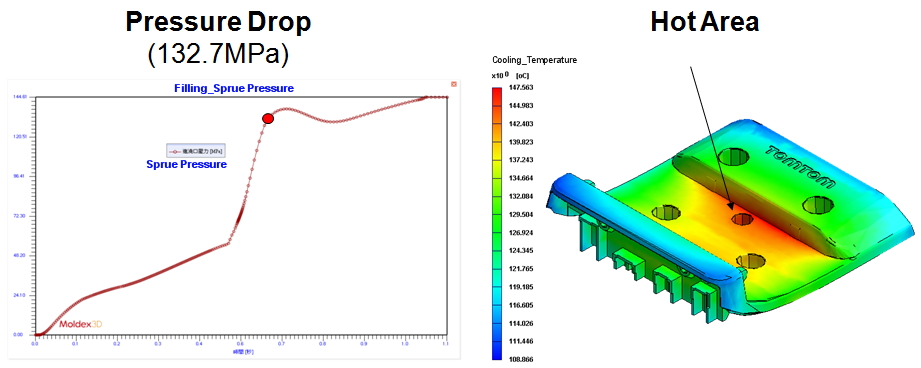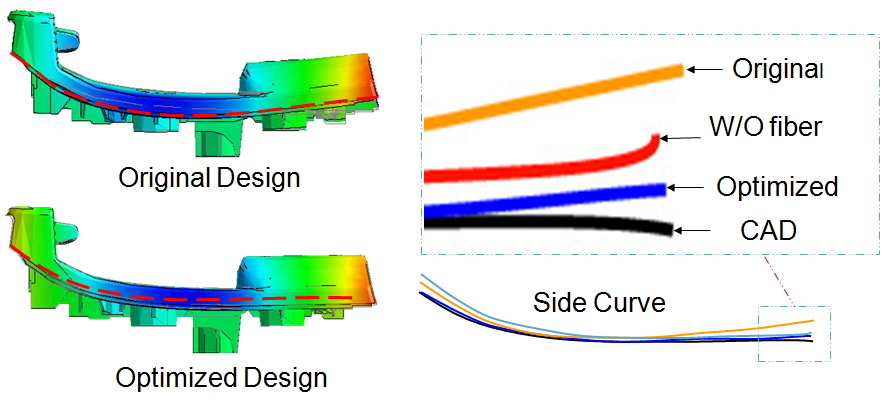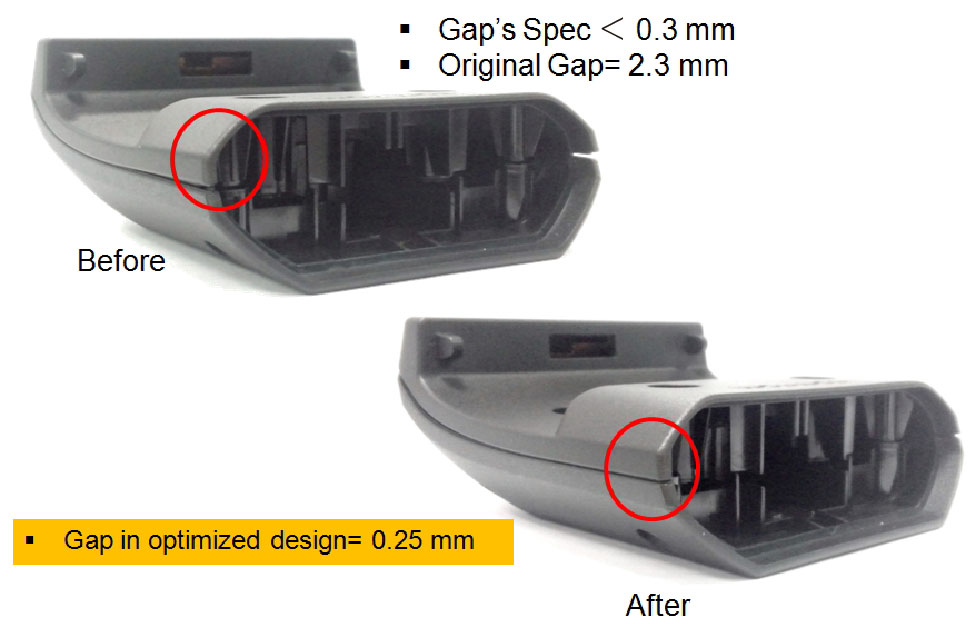Â
Customer Profile
- Customer:Â TomTom Asia
- Region: Taiwan
- Industry:Â Electronics
- Solution:Â Moldex3D eDesign / Moldex3D Fiber Module
- View PDF Version
TomTom is the world’s leading supplier of in-car location and navigation products and services focused on providing the world’s best navigation experience. TomTom’s products include portable navigation devices, smart phone apps, GPS sports watches, in-dash infotainment systems, fleet management solutions, and maps and real-time services, including the award winning TomTom HD Traffic.
(Source: https://www.tomtom.com )Â
Executive Summary
The product in this case is a front cover of the cradle of a truck GPS navigation system. Deformation is a significant issue that has to be controlled in order to conform to the aesthetic and assembly requirements. In the original design, the maximum deformed magnitude could reach 2.3mm whereas the qualified value should have been less than 0.3mm. TomTom used Moldex3D to design several trial methods and predict each warpage results. As a result, they were able to obtain the most effective design and meet the specification.
Challenges
- The mold trials display a serious deformation issue.
- The gap exceeds the required spec. (<0.3mm)Â
 Fig. 1 Â The deformed situation of a real product showed 2.3mm which was over the spec. requirement.
Fig. 1 Â The deformed situation of a real product showed 2.3mm which was over the spec. requirement.
Solutions
TomTom utilized Moldex3D eDesign to simulate the temperature, pressure drop and mechanical perspectives of several improved designs and was able to find out the most optimized design.
Benefits
- The assembly gap has been significantly reduced from 2.3mm to 0.25mm
- Reduced mold trials
- Raised the yield rate from 55% to 92%
- Reduced the cost by USD$20,000 and development time by 6 weeks.
Case Study
The product in this case is the front cover of a cradle, and its main function is to lend support to the navigation device. The objective of this case is to reduce serious warpage after molding. TomTom utilized Moldex3D eDesign to simulate the molding scenario of the original design and observed obvious issues. In the original design, the front cover is locked with the mating part and there is a 2.3mm gap which exceeds the spec. of 0.3mm. Fig.2 shows the CAD model and its simulation result, in which serious warpage at the edge of the part can be observed. The dotted line in Fig. 2 shows the deformed tendency. It will affect the assembly and cause shape defects that would have a direct negative impact on the dimensional functionality and its physical appearance. Thus, in order to solve this problem and produce high-quality products with fine aesthetic attributes, TomTom considered applying several alternative revised designs.
 Fig. 2 Â The CAD model of the original design (left) and its simulation result (right)
Fig. 2 Â The CAD model of the original design (left) and its simulation result (right)
Fig. 3 shows a large pressure drop and it is a critical factor that dominates deflection. Thus, the following study mainly focuses on how to reduce this pressure drop. Apart from the pressure drop, uneven heat distribution is another factor of deformation and will also be considered in the revised design.
 Fig. 3 Â (Left) Original design of simulated sprue pressure results ;Â (Right) Heat accumulation in the center region
Fig. 3 Â (Left) Original design of simulated sprue pressure results ;Â (Right) Heat accumulation in the center region
TomTom considered three influential factors including thermal, mechanical and pressure drop to reduce warpage. Table 1 shows the 6 design changes proposed by TomTom and the contributing factors they considered.
|
Considered Factors
of Warpage
|
Revised Design
|
Design Changes
|
Targets
|
|
Thermal factors
|
Type A
|
Add cooling channels in the hot area
|
To increase the cooling efficiency and diminish mold temperature differentials
|
|
Mechanical factors
|
Type B
|
Add ribs in the weak area
|
To strengthen the weak region to maintain the shape accuracy
|
|
Pressure drop factors
|
Type C
|
Change the gate locations and numbers
|
To improve flow balance and reduce the pressure drop for a more uniform pressure distribution
|
|
Type D
|
Increase the wall section by 0.3 mm
|
To enhance the packing efficiency and melt pressure of the penetration in order to achieve uniform volumetric shrinkage
|
|
Type E
|
Reduce the length of the runner
|
To shorten the flow path to increase the packing efficiency and achieve uniform volumetric shrinkage
|
|
Type F
|
Change the cold runners to hot runners
|
To reduce the length of runner (This mechanism is the same as type E).
|
Table 1 The 6 design changes
Table 2 is the summary of the pressure drop, warpage of the original and each revised design. As shown in the results, Type C, D, E and F have a higher contribution on warpage reduction. Thus, TomTom combined these 4 design changes as the optimized design. Fig. 4 shows the comparison of the optimized design with the lowest pressure, 31.25 MPa, and the minimum deviation with the CAD model.
Type
|
Pressure Drop (MPa)
|
Side Curve Warpage
(%) Compared to CAD
|
| Original |
138.33 |
31 |
| Type A |
138.28 |
30 |
| Type B |
137.31 |
28.2 |
| Type C |
88.26 |
15.71 |
| Type D |
86.58 |
14.32 |
| Type E |
73.21 |
17.26 |
| Type F |
52.17 |
8.59 |
|
Table 2 Summary of pressure drop and warpage conditionÂ
 Fig. 4 Â Optimized profile of deflection diagram
Fig. 4 Â Optimized profile of deflection diagram
After the design modification, TomTom used Moldex3D eDesign to simulate both the original design and the optimized design. The analysis results of the original product design showed obvious warpage. In the optimized design, there is a qualified magnitude and significant improvement on warpage. Next, TomTom compared the simulation results with the actual mold trial results and found a high correlation between both results. The original gap is 2.3mm and the gap in the optimized design has been reduced to 0.25mm, which is a great improvement.
 Fig. 11 Â The photo of actual molded part in original and optimized gap
Fig. 11 Â The photo of actual molded part in original and optimized gap
Results
Through Moldex3D’s analysis, TomTom clearly understood the deformed tendency and was able to predict the potential manufacturing difficulties prior to actual production. In the end, TomTom was able to successfully solve manufacturing issues and optimize the product and mold designs.
Rough Terrain Crane
40 Ton Terrain Crane,Wheel Mobile Crane Drive, Terrain Crane,XCMG terrain Crane,Rough Terrain Crane
Xinghan Muzhi Digital Technology (Xuzhou) Co., Ltd. , https://www.steelkingkong.com
![]()
 Fig. 1 Â The deformed situation of a real product showed 2.3mm which was over the spec. requirement.
Fig. 1 Â The deformed situation of a real product showed 2.3mm which was over the spec. requirement. Fig. 2 Â The CAD model of the original design (left) and its simulation result (right)
Fig. 2 Â The CAD model of the original design (left) and its simulation result (right) Fig. 3 Â (Left) Original design of simulated sprue pressure results ;Â (Right) Heat accumulation in the center region
Fig. 3 Â (Left) Original design of simulated sprue pressure results ;Â (Right) Heat accumulation in the center region Fig. 4 Â Optimized profile of deflection diagram
Fig. 4 Â Optimized profile of deflection diagram Fig. 11 Â The photo of actual molded part in original and optimized gap
Fig. 11 Â The photo of actual molded part in original and optimized gap